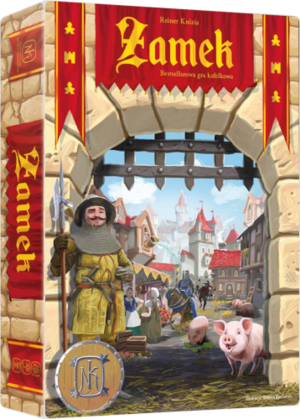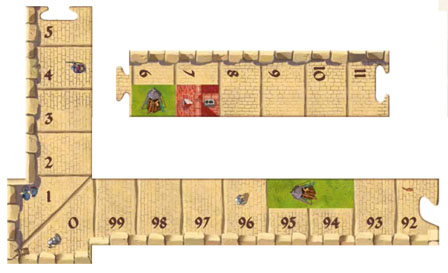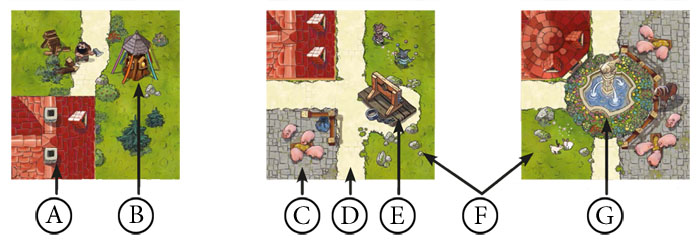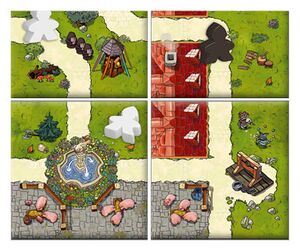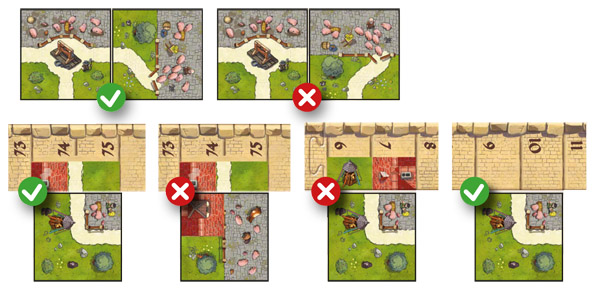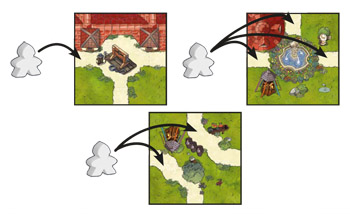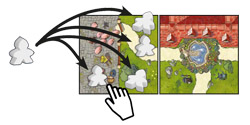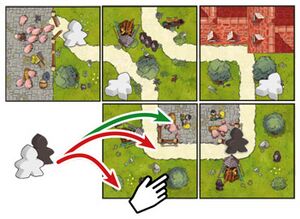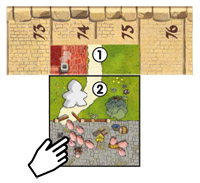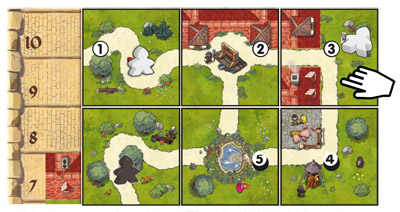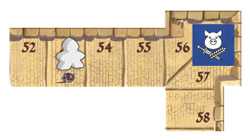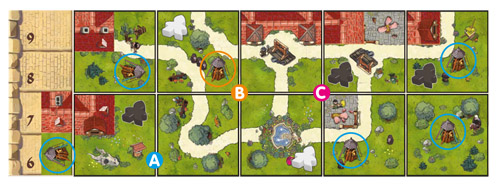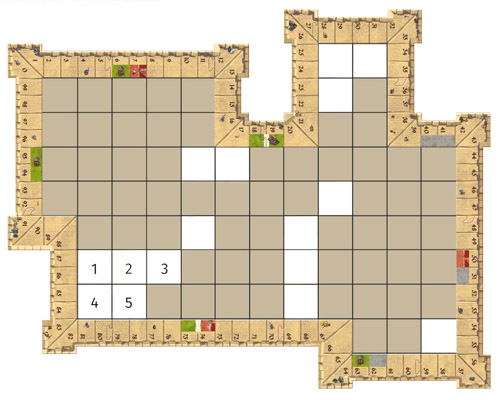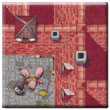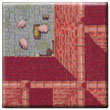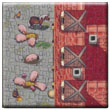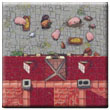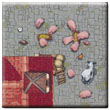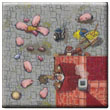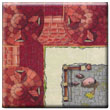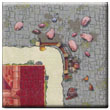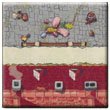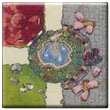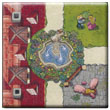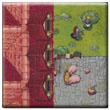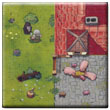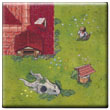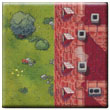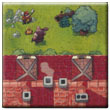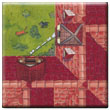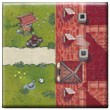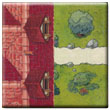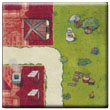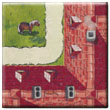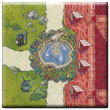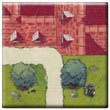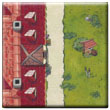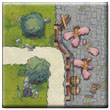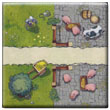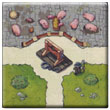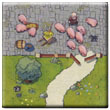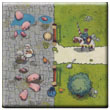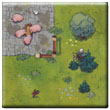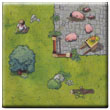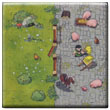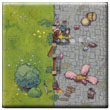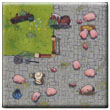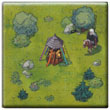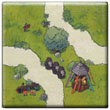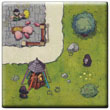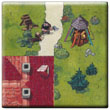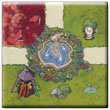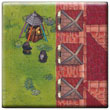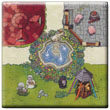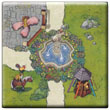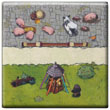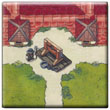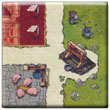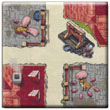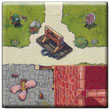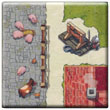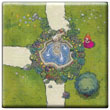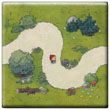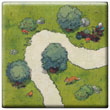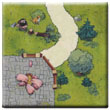Zamek Juego Base
Información general y comentarios
Zamek fue publicado en 2020 en polaco por Nasza Ksiegarnia. Se trata de una adaptación completa de El Castillo, con nuevas ilustraciones y algunos cambios en las características.
Dos familias compiten por el control del castillo en el que se desarrolla el juego. Añadiendo losetas, creas una red de caminos, prados, casas y pocilgas, sobre la que intentas hacerte con el control. Heraldos, monjes, escuderos y granjeros te ayudarán a tomar el control de los edificios del castillo y a ganar puntos. También recibirás puntos por dos objetos que deben estar presentes en todo buen castillo: los santuarios y el cepo. Al final de la partida, la persona con más puntos se hace con el control del castillo y mete a su rival en el cepo.
Contenido
- 10 Piezas de Muro del castillo
- 60 losetas de castillo
- 18 fichas de muro (dos de cada ficha mostrada)
- 14 seguidoress in 2 colores, y 2 casas familiares en 2 colores
- ¡Una pegatina para que puedas firmar tu copia del juego!
Cambios en el diseño
Estos son los principales cambios entre El Castillo y Zamek.
- La plaza (característica que separaba un camino en 3 caminos distintos) es una fuente («fontanna»).
- La fuente (característica que hace que los caminos puntúen 2 veces por loseta, y parece un pozo) es un cepo («dyby»).
- La Torre se ha redibujado como una pocilga («chlew»).
- El patio pasa a llamarse pradera («łąka»).
- El Mercado, situado en un Patio, ha sido sustituido por un Santuario o Capilla («kapliczka»).
- Las dos piezas de guarda se han sustituido por casas familiares que utilizan un meeple de «puerta» («dom»).
Objetivo del juego
Dos familias compiten por el control del castillo en el que se desarrolla el juego. Añadiendo losetas creas una red de caminos, prados, casas y pocilgas, sobre la que intentas hacerte con el control. Tienes que hacer un uso inteligente de tus seguidores - heraldos, monjes, escuderos y granjeros - que te ayudarán a tomar el control de los objetos del castillo y ganar puntos.
También recibirás puntos por dos objetos que deben estar presentes en todo castillo decente: santuarios y ''cepos. Al final de la partida, la persona con más puntos se hace con el castillo y mete a su rival en el cepo.
Preparación del juego
(A) Coloca las losetas tal y como se muestra. El muro forma una pista de puntuación (de 0 a 99). Es el borde del área de juego. Observa que varias losetas del muro tienen espacios de inicio.
(B) Coloca las 18 fichas especiales boca abajo sobre la mesa y barájalas. A continuación, coloca 1 ficha en cada torre de defensa (excepto en las que tengan espacios 0 y 1). Vuelve a poner las fichas no utilizadas en la caja (sin mirarlas).
(C) Coloca 60 losetas sobre la mesa boca abajo y barájalas. A continuación, haz varios montones con ellas y colócalos fuera de los muros del castillo.
(D) Coge 1 casa familiar y 6 seguidores del color elegido y colócalos frente a ti.
(E) Cada jugador coloca 1 seguidor en la casilla cero del marcador.
Desarrollo del juego
El juego lo inicia la persona que fue la última en las acciones (o el jugador de más edad). En su turno, un jugador puede realizar 3 acciones en el siguiente orden:
- Añadir una loseta
- Colocar un seguidor en el castillo
- Anotar puntos
1. Añadir una loseta
El jugador coge 1 loseta de cualquier pila y la coloca dentro de las murallas según las siguientes reglas:
- The first tile added in the game must be adjacent to one of the starting spaces. These spaces are treated as tiles.
- Each subsequent tile must be adjacent to at least one side of any of the starting spaces or to another tile.
- A road must be connected to another piece of road – both the one on the tiles and the starting spaces. Note! The exception is the wall. The road on the tile can be in contact with the bricks of the wall.
- Houses, pigsties and meadows can be added to each other in any way you like.
- You can add anything to the wall: a road, a house, a pigsty and a meadow.
- Tiles should be placed with their whole sides together. They can be rotated in any direction.
- If a player doesn't have the possibility to add a tile, he shows it to his rival, puts the tile back in the box and takes a new one from the stack. He then adds it according to the rules described above within the castle walls.
2. Placing a Follower into the Castle
On the just-placed tile the player may (but is not required to) place one follower from his or her supply. If the player doesn't have any more followers in his supply, he skips this action. When placing a follower in the castle, the player may place the follower on one of the areas on the currently placed tile: the house, the pigsty, the road or the meadow. Depending on where the follower is placed, it will have a different function.
When sending a monk to a meadow, lay him down. It will lie there until the end of the game (it will not return to the player's supply). Followers sent to roads, houses and pigsties are placed on them. They will stay there until the area they are standing on is finished (then they return to the player's follower supply).
Example:
A player adds a tile with a pigsty, two meadows and a road. On one of these areas he can place a follower. If he chose one of the two meadows, he would have to lay a follower there. If he chose either the pigsty or the road, he would have to place a follower there.
If a player has no followers in his supply, he does not send a follower to the castle on his turn. However, when a follower returns to the player's supply during the game, the player may use it again.
Fight for control of the areas
An added tile enlarges a road, house, pigsty or meadow. If there is already a follower (of any player), the player cannot send his follower to that area.
Remember, it doesn't matter how many tiles away a follower who is already in an area is - he controls the entire area and no player can add another follower there.
Connecting Controlled Areas
An added tile may cause player-controlled areas to merge. If this happens, the player cannot send his followers to the connected area, and followers in the merged areas remain in their positions.
Example:
The player has added a tile with a pigsty, a road and a meadow.
- The player has connected 2 roads controlled by the white player and the black player. Heralds standing on the road remain in their places, and the player may not place a herald on the added tile.
- The player has connected 2 meadows controlled by the white player. Monks lying on the meadow remain in their places, and the player cannot place a monk on the added tile.
- The player has also enlarged the pigsty, which is not controlled by anyone.
So the player can send his farmer there.
3. Scoring Points
If the added tile has completed building a road, house or pigsty, the points scored are counted. The completion of the construction means that the area is closed and cannot be extended any further. You mark the points scored by moving your followers on the score track.
Remember that the points for completed areas apply to the road, house and pigsty, but not to the meadow! Meadow points are awarded at the end of the game (which is why monks lie in meadows waiting for the game to end).
Points for a completed area are scored by the player with more followers in that area. In the event of a tie, no player scores points.
Remember, it doesn't matter which player adds the tile causing a road, house or pigsty to be completed. Points are scored by the player with more followers in the enclosed area.
If both players have scored points for completed areas after the tile was added, the first player to score points is the player whose turn it is. This is important when removing tokens from the track (this will be explained later).
A Completed Road
A player with more heralds on a complete road scores 1 point for each tile on that road.
If there are stocks next to a completed road, the player receives not 1, but 2 points for each tile making up that road. More than one stock does not give any additional points! Just one stock is enough to score 2 points per road tile.
A Completed Pigsty
A player with more farmers on a completed pigsty scores 2 points for each tile that makes up that pigsty.
A Completed House
The player who has more squires on a completed house scores 1 point for each tile that makes up that house.
After scoring points for the first completed house, it becomes the family house. The player places his follower symbolizing the family house on it.
Each time a player scores a larger house (consisting of more tiles), he moves the family house there.
At the end of the game, the family house is the largest house for which a player has earned points.
Remember that once points have been awarded for a completed road, house or pigsty the followers standing on them return to their respective players. These followers can be sent back to the castle later in the game in any role: as heralds, farmers, squires or monks.
Gaining Special Tokens
The special tokens are placed on the defense towers on the castle wall (on the scoring track). Each tower covers 2 tiles on the scoring track (e.g. spaces 56 and 57). If a follower stops on one of those spaces, the player takes the special token and puts it in front of him (face up). However, if the follower passes the token space, the player does not gain a special token. [1]
Example:
To get the special token the white player must score 3 or 4 points. His follower will then stop on space 56 or 57. If he scores more and passes these spaces, he cannot take this token.
- A player may use an acquired special token on his next turn or later in the game. He may not use it immediately after capturing it.
- A player may have any number of special tokens.
- A player may use any number of special tokens during his turn.
- The used special tokens should be put back in the box.
A description of the special tokens can be found at the end of the instructions.
Player's turn ends
After the player has added the tile, placed a follower in the castle, and scored points, the player's turn ends. His opponent takes his turn.
End of game
The game ends when all the tiles in the stacks have been used.
- Put the special tokens left on the score track back in the box.
- Then the players score points for meadows and family houses (according to the rules below) – they add them to the points scored during the game.
The player with the most points scored is the winner. In case of a tie, the players share the victory.
Points for Meadows
- Consider any meadow that has at least 1 monk in it - regardless of whether the meadow is completed or not.
- A player with more monks in a meadow scores 3 points for each shrine in that meadow. He moves his follower on the score track by the appropriate number of spaces. In case of a tie, no player scores points.
Points for the Family House
- At the end of the game, there are always at least 16 empty spaces (without tiles) left within the castle walls. You count how many spaces the largest empty area occupies.
- Then you check which player has the larger family house (i.e., how many tiles the house on which the family house stands is made of).
- The player who has the larger family house scores as many points as the largest empty area. A player moves his/her pawn on the on the track by the appropriate number of spaces. In case of a tie, no player scores points.
Example:
In this case, the largest empty area has 5 tiles. The player with the larger family house therefore scores 5 points.
Description of wall tokens
Total Wall Tiles: 18
Tile Distribution
Total Regular Tiles: 60
Credits
Illustration: Roman Kucharski
Notas
Para información sobre el significado de los Iconos y su licencia de uso, visita la Página de iconos.
- ↑
 Each area is scored separately, so the order in which they are scored can be important if it is possible to land on a tower segment with a wall tile with the first.
Each area is scored separately, so the order in which they are scored can be important if it is possible to land on a tower segment with a wall tile with the first.
